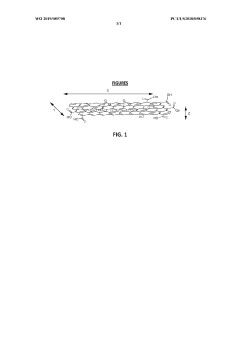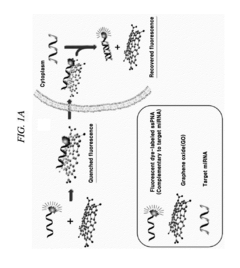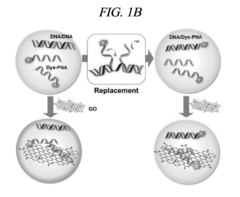How to Detect Graphene Oxide?
Graphene Oxide Detection Background and Objectives
Graphene oxide (GO) has emerged as a revolutionary material in the field of nanotechnology, attracting significant attention from researchers and industries alike. This two-dimensional carbon-based material, derived from graphene, possesses unique properties that make it valuable for various applications, including electronics, energy storage, and biomedical engineering. The detection of graphene oxide has become increasingly important due to its widespread use and potential environmental and health implications.
The evolution of graphene oxide detection techniques has been closely tied to the development of graphene-based materials. Since the isolation of graphene in 2004, researchers have been exploring methods to produce, characterize, and detect its derivatives, including graphene oxide. The ability to accurately detect and quantify GO is crucial for quality control in manufacturing processes, environmental monitoring, and assessing potential health risks associated with exposure.
The primary objectives of graphene oxide detection research are multifaceted. Firstly, there is a need to develop highly sensitive and selective detection methods that can identify GO in complex matrices, such as environmental samples or biological tissues. Secondly, researchers aim to create rapid and cost-effective detection techniques that can be implemented in real-time monitoring systems. Thirdly, there is a focus on developing portable and user-friendly detection devices for on-site analysis, which would greatly enhance the practicality of GO detection in various settings.
Another key objective is to establish standardized detection protocols that ensure consistency and reliability across different laboratories and applications. This standardization is essential for comparing results from different studies and for regulatory purposes. Additionally, researchers are working towards improving the detection limits of GO, aiming to identify even trace amounts of the material in diverse environments.
The technological trends in GO detection are moving towards the integration of advanced analytical techniques with nanomaterial science. This includes the development of novel sensing platforms based on optical, electrochemical, and spectroscopic methods. There is also a growing interest in leveraging artificial intelligence and machine learning algorithms to enhance the accuracy and efficiency of GO detection systems.
As the applications of graphene oxide continue to expand, the importance of robust detection methods becomes increasingly apparent. The ability to accurately detect and characterize GO not only supports its safe and effective use in various industries but also contributes to our understanding of its environmental fate and potential health impacts. Future research in this field is expected to focus on overcoming current limitations and developing innovative approaches to meet the evolving challenges of GO detection.
Market Analysis for Graphene Oxide Detection Methods
The market for graphene oxide detection methods has been experiencing significant growth in recent years, driven by the increasing applications of graphene oxide in various industries and the growing concern for its potential environmental and health impacts. The global market for graphene oxide detection is expected to expand rapidly, with a compound annual growth rate (CAGR) projected to be in the double digits over the next five years.
The primary sectors driving the demand for graphene oxide detection methods include electronics, biomedical, environmental monitoring, and materials science. In the electronics industry, the need for quality control in graphene oxide-based components has led to increased adoption of detection technologies. The biomedical sector is another key market, where graphene oxide is used in drug delivery systems and biosensors, necessitating accurate detection methods for safety and efficacy.
Environmental monitoring agencies and research institutions are also significant contributors to market growth, as they require reliable methods to detect graphene oxide in water, soil, and air samples. This is particularly important given the growing concerns about the potential environmental impact of nanomaterials.
The market for graphene oxide detection methods can be segmented based on technology type, including spectroscopic methods (such as Raman spectroscopy and UV-Vis spectroscopy), microscopy techniques (like atomic force microscopy and transmission electron microscopy), and electrochemical methods. Each of these segments is experiencing growth, with spectroscopic methods currently holding the largest market share due to their versatility and reliability.
Geographically, North America and Europe are the leading markets for graphene oxide detection methods, owing to their advanced research infrastructure and stringent regulatory frameworks. However, the Asia-Pacific region is expected to witness the fastest growth in the coming years, driven by increasing industrialization and research activities in countries like China, Japan, and South Korea.
Key market trends include the development of portable and rapid detection devices, which are gaining traction due to their convenience and potential for on-site analysis. Additionally, there is a growing focus on developing multi-modal detection systems that combine different techniques to improve accuracy and sensitivity.
The market is characterized by intense competition among key players, including both established analytical instrument manufacturers and emerging startups specializing in nanomaterial detection. These companies are investing heavily in research and development to improve detection sensitivity, reduce analysis time, and lower costs.
Current Challenges in Graphene Oxide Detection
Despite significant advancements in graphene oxide (GO) research, the detection and characterization of this material still present several challenges. One of the primary difficulties lies in the heterogeneous nature of GO samples, which can vary significantly in terms of size, shape, and oxidation level. This variability makes it challenging to develop standardized detection methods that are universally applicable across different GO preparations.
The sensitivity of current detection techniques is another major hurdle. Many existing methods struggle to detect low concentrations of GO, particularly in complex matrices such as biological samples or environmental specimens. This limitation hinders the ability to accurately assess the presence and potential impacts of GO in various applications and ecosystems.
Interference from other carbon-based materials poses a significant challenge in GO detection. Distinguishing GO from other graphene derivatives, carbon nanotubes, or even organic matter in environmental samples can be problematic. This issue is particularly acute in spectroscopic methods, where overlapping signals can lead to false positives or inaccurate quantification.
The dynamic nature of GO further complicates detection efforts. GO can undergo reduction or further oxidation depending on environmental conditions, altering its properties and potentially affecting detection outcomes. This instability necessitates the development of robust detection methods that can account for these potential changes.
Reproducibility and reliability of detection methods are ongoing concerns. The lack of standardized protocols for GO synthesis and characterization contributes to inconsistencies in detection results across different laboratories and studies. This variability hampers the comparison of research findings and the establishment of reliable safety guidelines for GO use and exposure.
The need for specialized equipment and expertise in many current detection techniques limits widespread adoption and application. High-end analytical instruments such as atomic force microscopy (AFM) or Raman spectroscopy, while powerful, are not always accessible or practical for routine testing or field applications.
Developing rapid and cost-effective detection methods remains a challenge. Many existing techniques are time-consuming and resource-intensive, making them unsuitable for high-throughput screening or on-site testing. This limitation is particularly problematic for environmental monitoring or quality control in industrial applications.
As GO finds increasing applications in various fields, including biomedicine and environmental remediation, there is a growing need for in situ and real-time detection methods. Current challenges include developing sensors or techniques that can provide immediate, accurate results in complex, dynamic environments without extensive sample preparation or processing.
Existing Graphene Oxide Detection Solutions
01 Synthesis and production methods of graphene oxide
Various methods for synthesizing and producing graphene oxide are described, including chemical exfoliation, oxidation of graphite, and reduction processes. These techniques aim to create high-quality graphene oxide with controlled properties for different applications.- Synthesis and production methods of graphene oxide: Various methods for synthesizing and producing graphene oxide are described, including chemical exfoliation, oxidation of graphite, and reduction processes. These techniques aim to create high-quality graphene oxide with controlled properties for different applications.
- Applications of graphene oxide in energy storage devices: Graphene oxide is utilized in energy storage devices such as batteries and supercapacitors. Its unique properties, including high surface area and conductivity, make it an excellent material for improving the performance and efficiency of these devices.
- Functionalization and modification of graphene oxide: Various methods for functionalizing and modifying graphene oxide are explored to enhance its properties and tailor it for specific applications. These modifications can include chemical treatments, doping, and composite formation with other materials.
- Graphene oxide-based sensors and detection methods: Graphene oxide is used in the development of highly sensitive sensors and detection methods for various analytes. Its unique electronic and optical properties make it suitable for creating advanced sensing platforms for chemical and biological applications.
- Environmental applications of graphene oxide: Graphene oxide is applied in environmental remediation and protection, including water purification, air filtration, and pollutant removal. Its high adsorption capacity and large surface area make it an effective material for addressing environmental challenges.
02 Applications of graphene oxide in energy storage devices
Graphene oxide is utilized in energy storage devices such as batteries and supercapacitors. Its unique properties, including high surface area and conductivity, make it an excellent material for improving the performance and efficiency of these devices.Expand Specific Solutions03 Functionalization and modification of graphene oxide
Various methods for functionalizing and modifying graphene oxide are explored to enhance its properties and tailor it for specific applications. These modifications can include chemical treatments, doping, and surface modifications to improve its performance in different fields.Expand Specific Solutions04 Graphene oxide-based composites and nanocomposites
The development of graphene oxide-based composites and nanocomposites is discussed, combining graphene oxide with other materials to create hybrid structures with enhanced properties. These composites find applications in various fields, including electronics, sensors, and structural materials.Expand Specific Solutions05 Characterization and analysis techniques for graphene oxide
Various characterization and analysis techniques are employed to study the properties and structure of graphene oxide. These methods include spectroscopic techniques, microscopy, and other analytical tools to understand the material's composition, morphology, and behavior.Expand Specific Solutions
Key Players in Graphene Oxide Detection Industry
The detection of graphene oxide is an emerging field in advanced materials science, currently in its growth phase. The market for graphene oxide detection technologies is expanding rapidly, driven by increasing applications in electronics, energy storage, and biomedical sectors. The global graphene market, including detection technologies, is projected to reach significant value in the coming years. Technologically, the field is progressing from early-stage research to more mature applications. Companies like Toray Industries, Nitto Denko Corp, and Cabot Corp are leading industrial efforts, while academic institutions such as the University of Manchester and Northwestern University are pushing the boundaries of research. The collaboration between industry and academia, exemplified by partnerships involving entities like Hanyang University and the University of Pennsylvania, is accelerating the development of more sophisticated and reliable detection methods for graphene oxide.
Toray Industries, Inc.
The Sixth Element (Changzhou) Materials Technology Co., Ltd.
Core Innovations in Graphene Oxide Detection
- A method involving washing crude graphene oxide with a dilute acidic solution, followed by redispersion in an aqueous solution and optional mild sonication, to produce larger sized graphene oxide platelets, flakes, or sheets, which can be filtered and centrifuged to achieve desired particle sizes and surface areas.
- A kit and method utilizing graphene oxide and PNA probes with fluorescent materials for nucleic acid detection, enabling multiplexed and real-time detection by quenching and unquenching fluorescent light based on hybridization, with PNA probes being stable against nuclease and protease degradation.
Environmental Impact of Graphene Oxide Detection
The detection of graphene oxide in the environment has significant implications for ecological systems and human health. As this nanomaterial gains widespread use in various industries, its potential release into ecosystems raises concerns about its environmental impact. The detection methods employed play a crucial role in assessing and mitigating these effects.
Graphene oxide particles, due to their nanoscale size, can easily disperse in air, water, and soil. Their presence in aquatic environments may affect marine life, potentially disrupting food chains and ecosystems. In terrestrial environments, graphene oxide can interact with soil microorganisms, potentially altering nutrient cycles and plant growth. The detection of these particles is essential for monitoring their concentration levels and distribution patterns in different environmental compartments.
The environmental fate of graphene oxide is closely linked to its detection capabilities. Accurate and sensitive detection methods enable researchers to track the movement and transformation of graphene oxide in various environmental matrices. This information is vital for understanding the long-term ecological consequences and developing appropriate risk assessment strategies.
Detection techniques also play a role in evaluating the potential bioaccumulation of graphene oxide in organisms. By identifying its presence in different trophic levels, scientists can assess the risk of biomagnification and its impact on biodiversity. Furthermore, the ability to detect graphene oxide in environmental samples aids in studying its potential synergistic effects with other pollutants, which may amplify environmental risks.
The development of reliable detection methods contributes to the establishment of environmental quality standards and regulations. As regulatory bodies seek to set acceptable limits for graphene oxide in air, water, and soil, accurate detection techniques become indispensable for compliance monitoring and enforcement. This, in turn, helps in mitigating the potential negative impacts on ecosystems and public health.
Moreover, the environmental impact of graphene oxide detection extends to waste management practices. Effective detection methods enable the identification of graphene oxide in waste streams, facilitating proper disposal and recycling processes. This is particularly important in industrial settings where graphene oxide is used in manufacturing processes, ensuring that environmental contamination is minimized.
In conclusion, the ability to detect graphene oxide in environmental samples is crucial for understanding and managing its ecological impact. As research in this field progresses, improved detection methods will contribute to more comprehensive environmental risk assessments and the development of sustainable practices in the use and disposal of graphene oxide-containing materials.
Standardization of Graphene Oxide Detection Methods
The standardization of graphene oxide (GO) detection methods is crucial for ensuring consistent and reliable results across different research and industrial applications. Currently, there is a lack of universally accepted protocols for GO detection, which can lead to discrepancies in reported findings and hinder progress in the field. To address this issue, several key areas require standardization.
Firstly, sample preparation techniques need to be unified. This includes establishing guidelines for GO dispersion in various solvents, concentration ranges, and storage conditions. Standardized protocols for sample purification and pre-treatment are essential to minimize interference from contaminants and ensure reproducibility.
Secondly, analytical techniques for GO detection must be standardized. While various methods such as UV-Vis spectroscopy, Raman spectroscopy, and X-ray photoelectron spectroscopy (XPS) are commonly used, there is a need for consensus on which techniques are most suitable for specific applications. Standardized protocols should outline the optimal instrument parameters, measurement conditions, and data analysis procedures for each technique.
Thirdly, the development of reference materials is critical for method validation and inter-laboratory comparisons. These reference materials should encompass a range of GO types with well-characterized properties, including lateral size, thickness, and oxidation degree. Establishing a set of certified reference materials would enable researchers to calibrate their instruments and validate their detection methods.
Furthermore, standardization efforts should address the quantification of GO in complex matrices, such as biological samples or environmental media. This requires the development of robust extraction and separation techniques, as well as guidelines for matrix effect compensation and recovery assessment.
Lastly, data reporting and interpretation standards are necessary to facilitate comparison of results across different studies. This includes establishing uniform units of measurement, defining key parameters to be reported, and providing guidelines for statistical analysis and uncertainty estimation.
Implementing these standardization measures will require collaboration between academic institutions, industry partners, and regulatory bodies. International organizations such as ISO and ASTM can play a crucial role in developing and disseminating these standards. By establishing a common framework for GO detection, the scientific community can enhance the reliability and comparability of research findings, accelerating progress in graphene-based technologies and applications.




